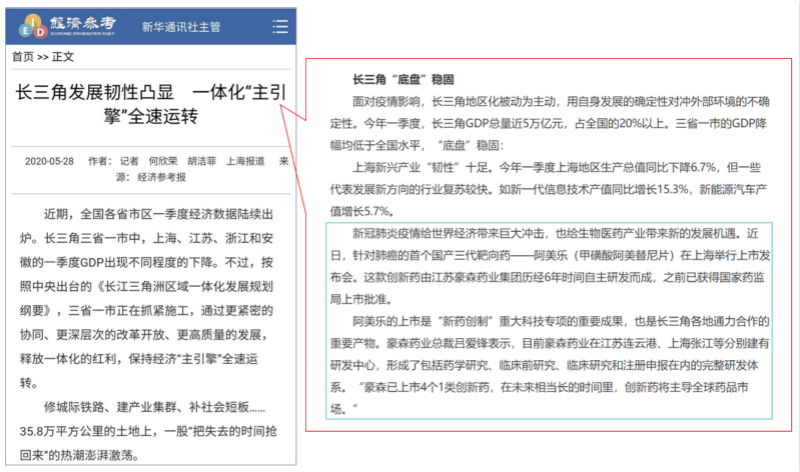Report on Page A8 by Xinhua News Agency's Economic Information Daily: Yangtze River Delta Demonstrates Resilience in Development, with the "Main Engine" of Integration Running at Full Speed
On May 28, Xinhua News Agency's Economic Information Daily published a report on Page A8: Yangtze River Delta Demonstrates Resilience in Development, with the "Main Engine" of Integration Running at Full Speed

Original text:
Recently, Q1 economic data of all provinces and municipalities in China have been released one after another. Of the three provinces and one municipality in the Yangtze River Delta, Shanghai, Jiangsu and Zhejiang, together with Anhui, showed different degrees of decline in Q1 GDP. However, according to the "Outline of the Yangtze River Delta Regional Integration Development Plan" released by the central government, the three provinces and one municipality are stepping up construction to unleash the potential of integration and keep the "main engine" of the economy running at full speed through closer coordination, deeper reform and opening up, and higher-quality development.
Building inter-city railways, establishing industrial clusters, and strengthening weak parts in the social sector... On the land of 358,000 km2, a wave of "taking back the lost time" is surging.
The "chassis" of the Yangtze River Delta is solid
Faced with the impact of COVID-19, the Yangtze River Delta region turned from passive response to proactive move, using the certainty of its own development as a hedge against the uncertainty of the external environment. In Q1 this year, the Yangtze River Delta's GDP was nearly RMB 5 trillion, accounting for more than 20% of the country's total. The GDP declines in the three provinces and one municipality were all lower than the national level, indicating a stable "chassis":
Shanghai's emerging industries are highly "resilient". In Q1 this year, Shanghai's GDP fell 6.7% YoY, but some industries representing new development directions recovered rapidly. For example, the output value of the new generation of information technology increased by 15.3% YoY, and that of new energy vehicles increased by 5.7%.
COVID-19 has brought great impact to the world economy and also new development opportunities to the biopharmaceutical industry. Recently, the launch meeting of Ameile (Ametinib Mesylate Tablets), the first domestic third-generation targeted drug for lung cancer, was held in Shanghai. This innovative drug was independently developed by Hansoh Pharma after 6 years' efforts, and has been approved by the National Medical Products Administration for marketing.
The launch of Ameile is an important achievement of the major scientific and technological project "New Drug Innovation and Development", and also an important product of the concerted efforts across the Yangtze River Delta. According to Lyu Aifeng, President of Hansoh Pharma, up to now, Hansoh Pharma has established R&D centers in Lianyungang, Jiangsu and Zhangjiang, Shanghai, forming a complete R&D system covering pharmaceutical research, preclinical research, clinical research, and registration application. "Hansoh Pharma has launched four Class 1 innovative drugs. For a long time to come, innovative drugs will dominate the global drug market."
Leveraging its comparative advantage in manufacturing, Jiangsu reported industrial growth in March. Statistics show that in Q1, Jiangsu's GDP fell 5% YoY, while in March, its industrial added value rose 5% YoY. Currently, Jiangsu is accelerating the development of industrial Internet, integrated circuit, high-end equipment and other advanced manufacturing clusters, trying to create a version 2.0 of "World Factory".
Zhejiang stood up against the pressure and achieved positive growth in foreign investment. According to the data from the Department of Commerce of Zhejiang Province, 539 new foreign-invested enterprises were established in Zhejiang Province in Q1, with the actual use of foreign capital reaching RMB 27.1 billion, up 0.3% YoY. What is more noteworthy is that more than one third of Zhejiang's new foreign investment in Q1 was additional investment of existing foreign capital.
Anhui focuses on the weak parts in economic and social development, reporting rapid investment growth in the social sector. Statistics show that Anhui's Q1 GDP fell 6.5% YoY, while investment in health and social work increased by 29% and investment in education increased by 16%. "Since March, Anhui's electricity consumption and highway traffic have obviously rebounded. We judge that the regional economy will continue to pick up in the next stage." Xiao Zhiying, chief statistician of Anhui Provincial Bureau of Statistics, said.
New infrastructure activates new economy; new economy unleashes new momentum
Taizhou of Zhejiang is the birthplace of Geely Automobile. In March this year, Geely again announced additional investment in Taizhou, to develop satellite business instead of automobile business this time.
Is Geely turning to build satellites? In the face of the doubts from the outside world, Geely Chairman Li Shufu explained, "From the Sino-US trade friction last year to COVID-19 this year, the automobile industry has been encountering tough challenges. We should not stay passive and just wait for the market to improve. Instead, we need to identify the development trend and proactively embrace changes."
Relying on the satellite test center in Taizhou, Geely will build an intelligent satellite production line with international influence and with products mainly used in the fields of communication, remote sensing and navigation, to accelerate its transition from an automobile manufacturer to a future mobility technology group. Geely is planning to have two satellites in space by the end of this year.
On the premise of secured overall performance, the competitive growth of the new economy has opened up new space for the development of the Yangtze River Delta.
New infrastructure activates new economy -
In the Lingang New Area of Shanghai Free Trade Zone, the construction of Shanghai Mobile International Data Center Phase II has resumed in full swing. The center has a total building area of 250,000m2, and will provide an installed capacity of more than 20,000 racks upon completion.
Whether in "cloud economy", "stay-at-home economy" or "non-contact economy", a large amount of data computing and storage is behind every web page people browse and every order they send. To accommodate the large amount of big data, the Yangtze River Delta has entered the "fast lane" to build data centers.
Alibaba announced the plan to invest hundreds of billions in cloud computing and data center; and Jiangsu is also planning to build Nanjing Location Service Data Center. According to Huang Haocheng, Deputy Director of Lingang Office of Engineering Department of China Mobile Group Shanghai Co., Ltd., "Traditional infrastructure consumes a lot of steel and concrete, while new infrastructure relies more on advanced equipment, technology and intelligence."
Yang Yiqing, Vice President of Zheshang Research Institute, Zhejiang Gongshang University, analyzed that the Yangtze River Delta has a solid manufacturing foundation, which is similar to strong computer hardware, new infrastructure represented by 5G and data center is like computer software, and the combination of the two can fuel system upgrade of the economic structure. "The digital economy in the Yangtze River Delta is in the forefront of the country, and can be built into a "role model" of new infrastructure, providing reference for the other parts of the country."
New economy unleashes new momentum -
Taimi Robotics Technology Co., Ltd., located in Zhangjiang Science City, Shanghai, did not take a break since the outbreak of COVID-19. "It is no exaggeration to say that the intelligent disinfection robots we have developed are already out of stock." Pan Jing, Founder of Taimi, said.
With a height of 1m+ and a capability of autonomous navigation to avoid obstacles, Taimi's intelligent disinfection robots are now in service at more than 200 hospitals across the country. According to Pan, from the very beginning of its establishment, Taimi has been committed to the production of "medical robots". Relying on a series of core technologies, Taimi finally turned its ambition into reality.
Strike while the iron is hot; further efforts have been made to develop "hard core" industries such as chips. In Q1 this year, Zhangjiang Science City reported RMB 66.2 billion in total industrial output value, RMB 10.65 billion in tax revenue, and RMB 6.68 billion in fixed assets investment. "All core economic indicators showed positive growth." Wu Qiang, full-time deputy director of Shanghai office for Promoting the Construction of Science and Technology Innovation Center, remarked.
According to the Report on High Quality Development Index in Yangtze River Delta compiled by Shanghai Huaxia Economic Development Research Institute, the Yangtze River Delta plays an important role in the overall development of the country; to turn pressure into momentum and turn crises into opportunities, the Yangtze River Delta needs to continue its focus on five aspects, namely, building new infrastructure, growing new economy, expanding new consumption, rolling out new services and exploring new mechanisms.
Accelerating integration to form synergy and tap new potential
With the advent of the digital economy era, data has become a new factor of production for economic and social development. Recently, Qingpu District of Shanghai, Jiashan County of Zhejiang, and Wujiang District of Suzhou, Jiangsu signed a reform memorandum to promote the open sharing of data in the Yangtze River Delta Eco-Green Integration Demonstration Zone and jointly build a "Digital Demonstration Zone".
Spanning Jiangsu, Zhejiang and Shanghai, the Yangtze River Delta Integration Demonstration Zone has been steadily advancing various tasks since its inauguration in November 2019. According to Weng Jianrong, deputy director of the Executive Committee of the Yangtze River Delta Integration Demonstration Zone, the integration of the demonstration zone is first of all the integration of data, and efforts need to be made to enable interconnection of data and mutual recognition of services in the two districts and one county, break administrative boundaries while maintaining administrative jurisdictions unchanged, and effectively benefit all parties through institutional innovation and digital industry development.
"Everyone is a generator and user of big data; we contribute to big data by tapping cell phones with fingers." According to Chu Zhaowu, head of Data Resources Department, Shanghai Big Data Center, during the COVID-19 outbreak, Shanghai has exchanged about 14.59 million pieces of health code data with Jiangsu, Zhejiang and Anhui through the health code inquiry service interface.
Ruan Huabiao, senior economist of Anhui Economic Information Center, said that the regional collaborative innovation community in the Yangtze River Delta is continuing to advance with breakthroughs in areas such as anti-COVID-19 drug R&D, big data and artificial intelligence applications.
Zhang Xueliang, executive dean of the Institute for Yangtze River Delta and Yangtze River Economic Belt Development, Shanghai University of Finance and Economics, remarked that accelerating the integration of the Yangtze River Delta to produce the effect of 1+1+1+1>4 is itself a process of unleashing new momentum. "Our investigation found that during the COVID-19 outbreak, some enterprises in the Yangtze River Delta encountered difficulties in importing key raw materials and spare parts and as a result switched to new partners in the local region. Through these actions that strengthen, supplement and expand industry chains, the construction of world-class industrial clusters in the Yangtze River Delta has been accelerated."
Integration means overall planning. In the Yangtze River Delta as a whole, the tougher the external challenge, the closer the internal collaboration, the greater the potential:
With the Lingang New Area of Shanghai Free Trade Zone in the east and the Hongqiao International Open Hub and Integration Demonstration Zone in the west, Shanghai's leading role is further highlighted;
Jiangsu promotes industrial innovation and integration in six aspects across the province, and takes the lead in exploring integrated system innovations for social security, medical treatment and old-age care;
Zhejiang leverages its unique advantages in digital economy and private economy, and includes major decisions and arrangements such as Greater Bay Area, Grand Garden and Grand Passage in the integration strategy;
Anhui contributes to integration by accelerating the development of Hefei-Wuhu-Bengbu National Independent Innovation Demonstration Zone and upgrading the Wanjiang Urban Belt to undertake the industrial transfer demonstration zone...
From "blueprint planning" to "construction implementation", the "main engine" of the Yangtze River Delta keeps running at full speed, which will open up new opportunities for the stable and healthy development of China's economy.
- Excerpt from Economic Information Daily of Xinhua News Agency

